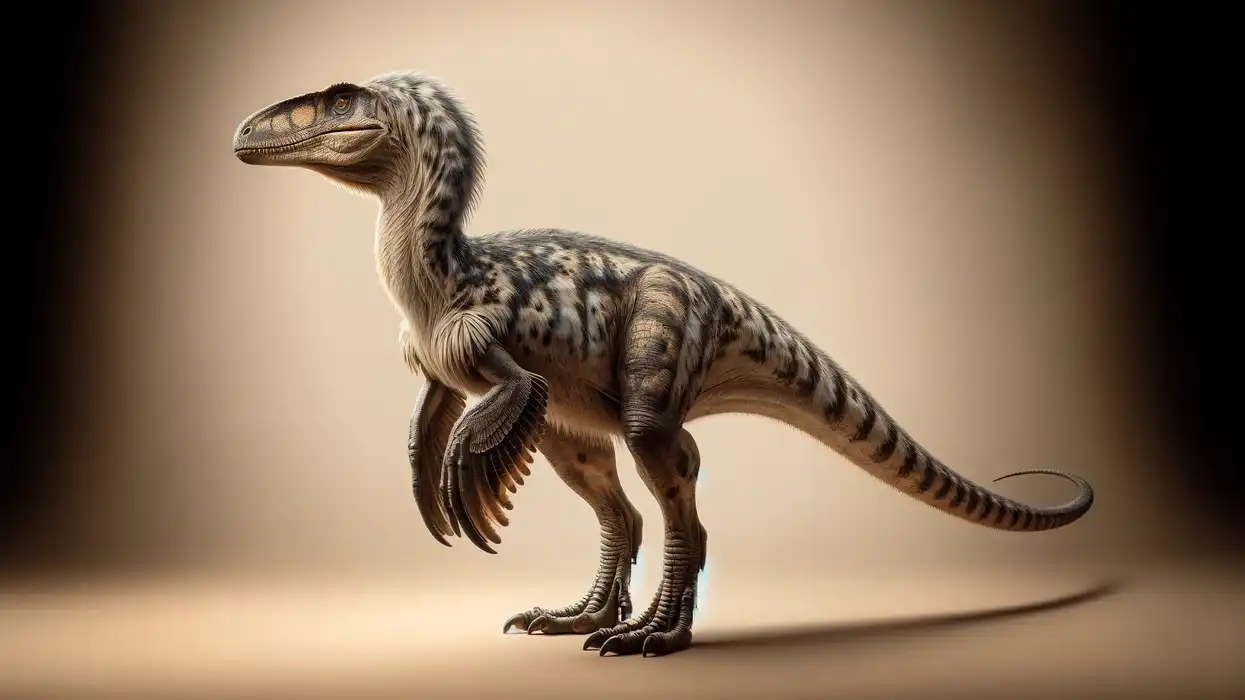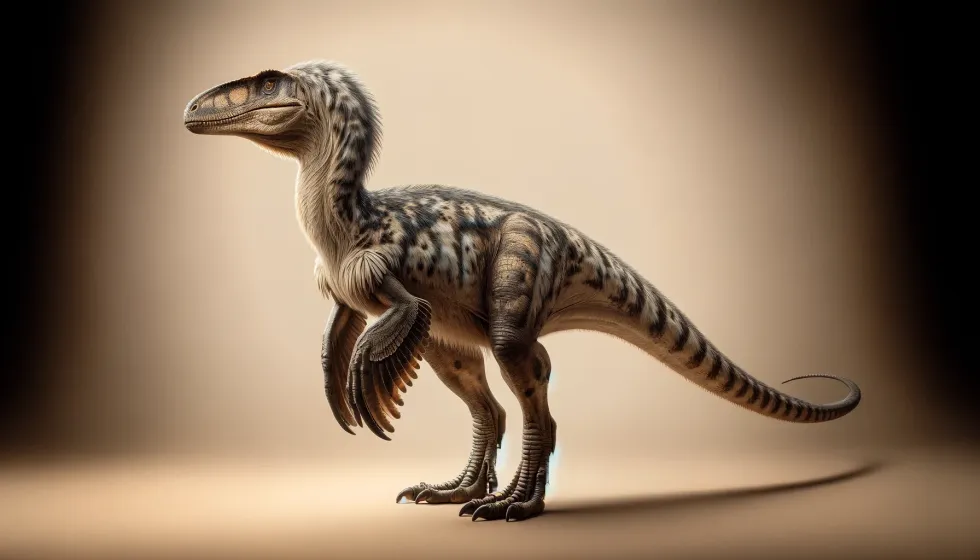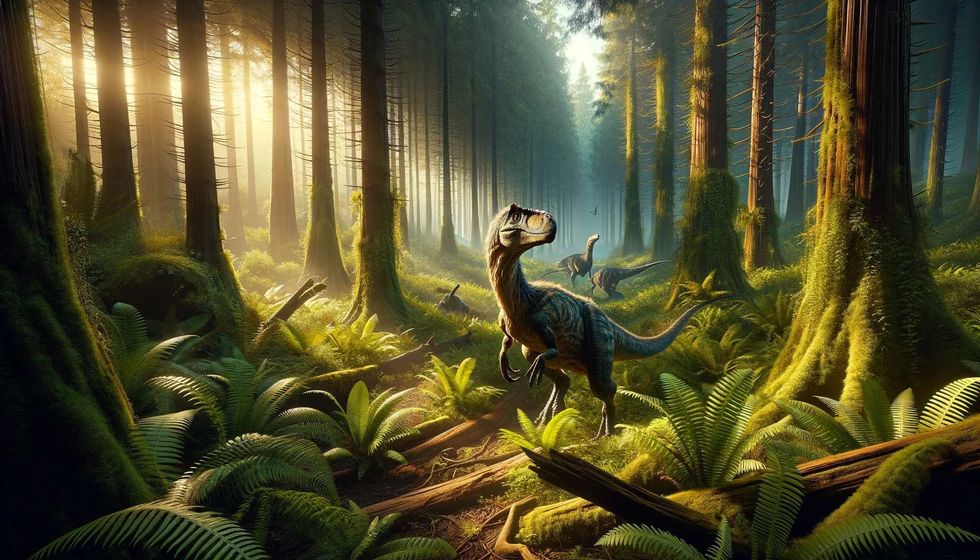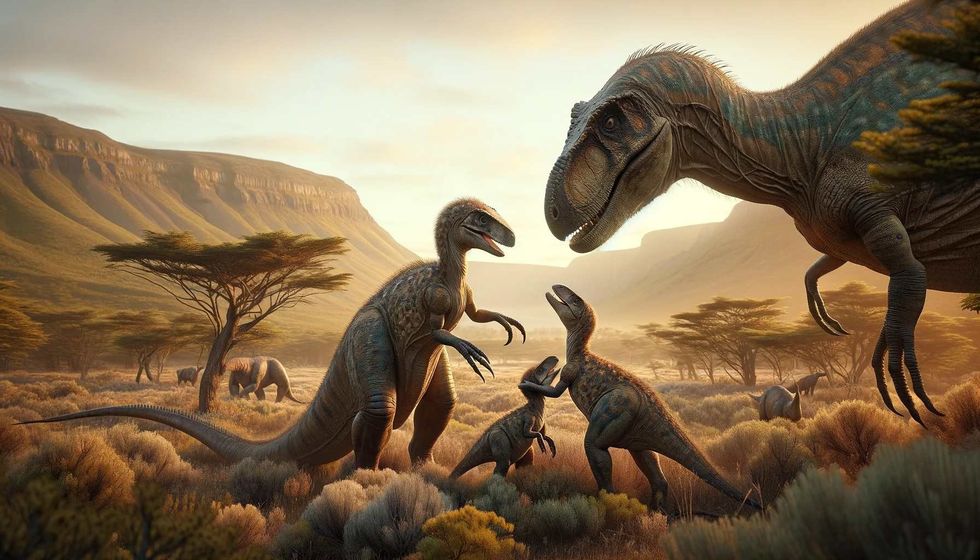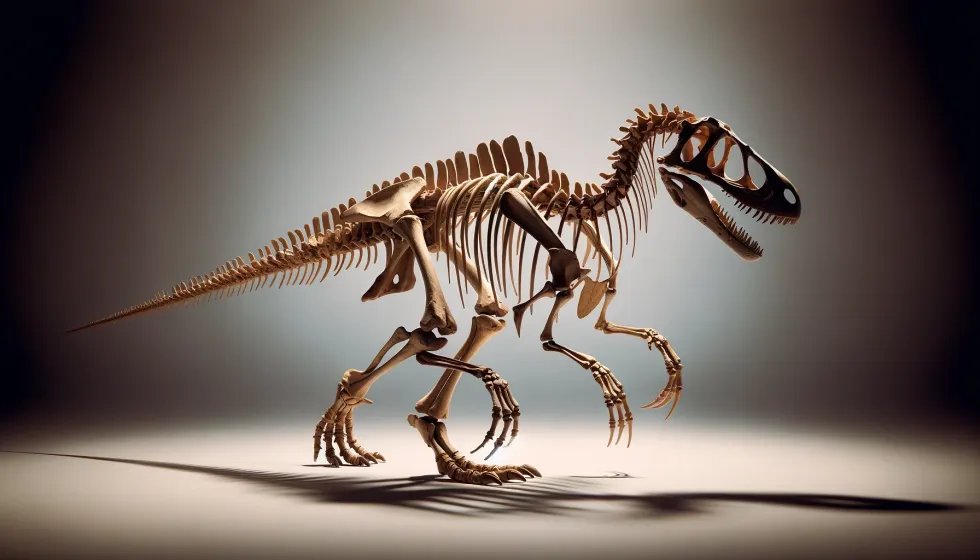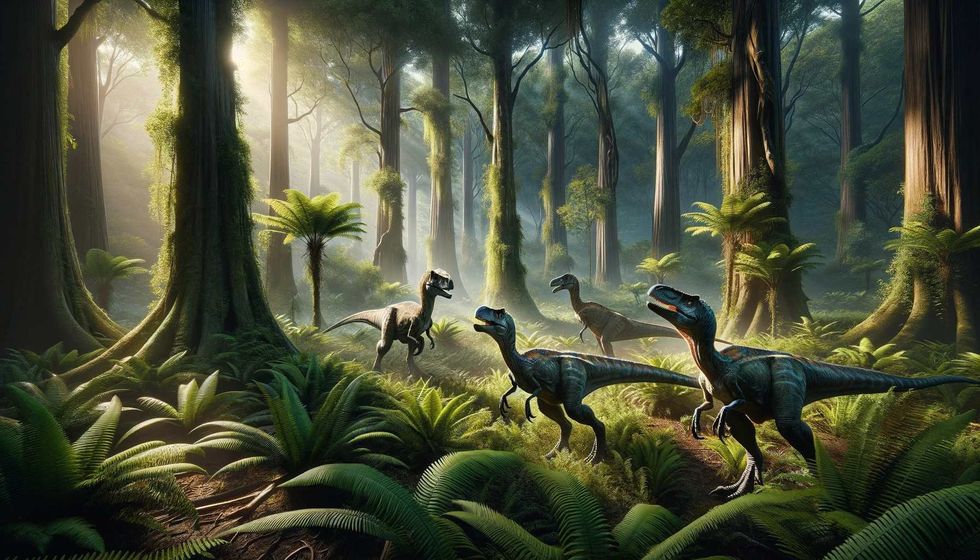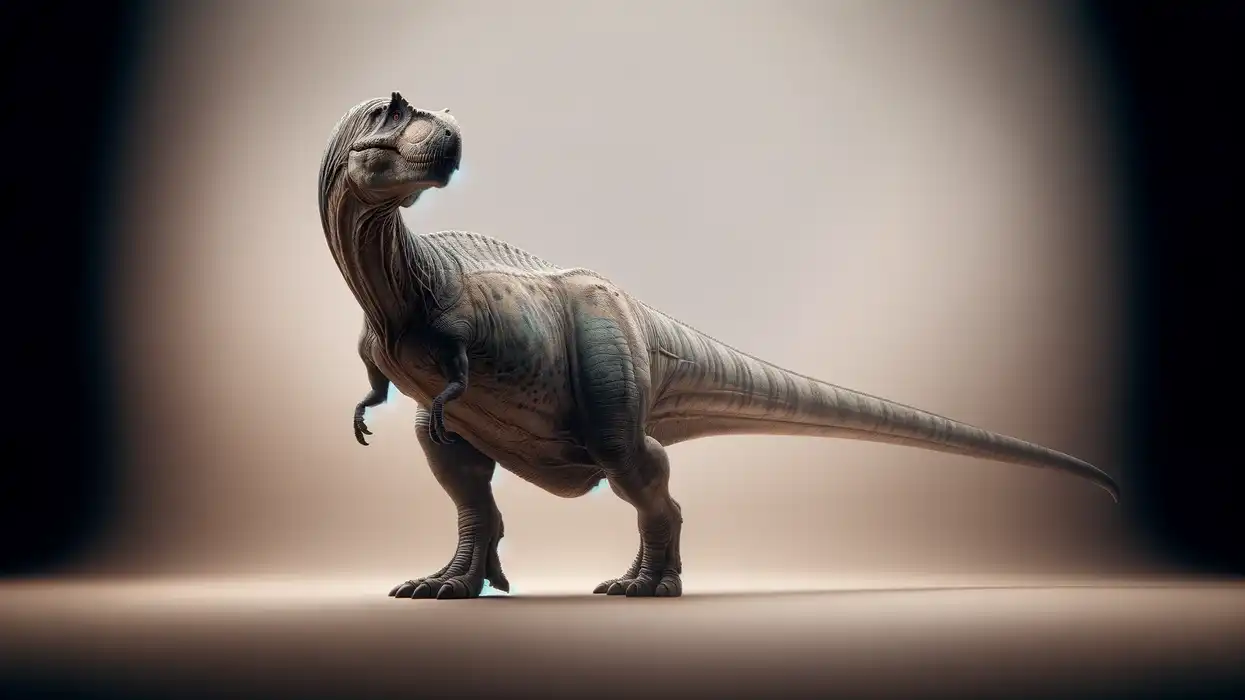The Megaraptor, whose name aptly means 'giant thief', stood out as a formidable megaraptoran theropod dinosaur of both significant stature and remarkable predatory features; most notably, its distinctive, sickle-shaped claws and powerful limbs.
These awe-inspiring creatures once traversed the diverse and vibrant lands of South America throughout the Upper Cretaceous Period (90-85 million years ago), leaving an indelible mark on the fabric of vertebrate paleontology.
Their existence showcases not only the diversity of life that thrived during the Late Cretaceous Period but also the intricate dynamics of prehistoric ecosystems. Within the annals of natural history, detailed studies of juvenile specimens, alongside more substantial findings from adult versions of this large theropod, unveil a profound evolutionary story.
These paleontological treasures illustrate how the Megaraptor's unique anatomical characteristics, such as their razor-sharp, sickle-shaped claws, robust hind legs, and potentially even feather-like integuments. These features enabled them to assume the role of apex predators within their ecological niche.
Far from mere relics of the past, these discoveries provide a richer understanding of the Megaraptor, painting a vibrant picture of a bird-like dinosaur whose reign over its territorial domain was as impressive as it was formidable, characterized by exceptional predatory skills that cemented its position at the top of the food chain.
Megaraptor Interesting Facts
How do you pronounce 'Megaraptor'?
'MEG-uh-RAP-tor' is the pronunciation of Megaraptor.
What type of dinosaur were they?
The Megaraptor was a large theropod dinosaur, part of the megaraptoran family, known for their sickle-shaped claws.
In which geological period did the Megaraptor roam the earth?
The Megaraptor lived during the Late Cretaceous Period (90-85 million years ago)
When did the dinosaur become extinct?
The Megaraptor met its demise shortly before the end of the Late Cretaceous period, approximately 66 million years ago.
Where did the dinosaur live?

This dinosaur inhabited the prehistoric landscapes of Argentina, South America.
What was a Megaraptor's habitat?
Megaraptors were likely to be found in forests, grassland, and riverine environments, where their predatory adaptations gave them an edge.
Who did they live with?
The Megaraptor coexisted in a diverse ecosystem alongside various dinosaur species and other wildlife. Its contemporaries included the massive titanosaurian sauropods like the Futalognkosaurus, Baalsaurus, and Malarguesaurus. Other co-inhabitants were theropods such as the Neuquenraptor, Unenlagia, and Pamparaptor, the small theropod Patagonykus, and the predatory abelisaurid Elemgasem.
The habitat was also populated by teleost fishes such as Leufuichthys, turtles like Portezueloemys and Prochelidella, as well as early birds and the pterosaur Argentinadraco, painting a picture of a vibrant Late Cretaceous landscape.
How long did they live?
The exact lifespan of the Megaraptor remains undetermined, with more comprehensive fossil data needed to pinpoint its average longevity.
How did they reproduce?

Like most theropods, they reproduced by laying eggs.
Megaraptor Fun Facts
What did a Megaraptor look like?
The Megaraptor stood as a towering bipedal theropod, characterized by its lean frame, extended forelimbs equipped with large, curved claws, and a formidable head, set with powerful jaws and razor-like teeth.
How many bones did a Megaraptor have?

The total number of bones a Megaraptor possessed is not precisely documented, but findings such as finger bones provide valuable insights.
How did they communicate?
Communication methods are speculative, but they may have used visual and auditory signals.
How big were they?
It was a large theropod, with a length of 26 ft (8m) and a height of about 6.5 ft (2 m).
How fast could a Megaraptor move?
The exact speed is unknown, but its anatomy implies a swift predator.
How much did a Megaraptor weigh?
The estimated weight was around 2,200 lb (1,000 kg).
What were the male and female names of the species?
Gender-specific names for Megaraptors do not exist.
What would you call a baby Megaraptor?
A baby Megaraptor would be called a 'juvenile' or a 'hatchling'.
How aggressive were they?
Their design for predation suggests they were highly aggressive when hunting.
Did you know...
The sickle-shaped claws of the Megaraptor have led to it being named a 'giant thief', a reflection of its mastery over the ancient ecosystem of its South American reign.
The discovery of a finger bone among Megaraptor fossils was pivotal in understanding its predatory arsenal, as it indicated the presence of large, formidable hand claws, a feature that distinguished this dinosaur from its contemporaries.
The species Megaraptor namunhuaiquii, identified by paleontologist Fernando E. Novas, was defined by significant traits such as a specialized finger bone, which supported its characteristic large hand claws.
Fossils of the adult version of the Megaraptor reveal this ancient predator's impressive size and suggest a fearsome presence in its Late Cretaceous environment.
The Megaraptor, equipped with its powerful limbs and sharp claws, served a super duty role in its ecosystem as a formidable apex predator during the Late Cretaceous Period.
Many aspects of the Megaraptor's biology and ecology, such as its hunting strategies and social behavior, still await study to fully understand this enigmatic creature's role in the Late Cretaceous ecosystem.
The first finger of the Megaraptor, bearing a large and formidable claw, was a crucial adaptation that established its reputation as a fearsome predator of the Late Cretaceous Period.
The Megaraptor, once considered a basal coelurosaur due to its primitive features, has been reclassified, shedding light on the intricate evolutionary pathways of theropod dinosaurs.
Studies on the Megaraptor have revealed that its sickle-shaped claws and agile build made it one of the most formidable predators of the Late Cretaceous Period.
Paleontologist Fernando E. Novas named the formidable theropod 'Megaraptor', reflecting its status as one of the most fearsome predators discovered from the Late Cretaceous Period.
The Megaraptor was initially mistaken for a giant dromaeosaurid due to its large claws; however, further research revealed it as a distinct genus of theropod dinosaur from the Late Cretaceous Period.
The classification of the Megaraptor has evolved over time as new fossils have emerged, solidifying its status as a distinct and significant predator within the theropod group during the Late Cretaceous.
The skeletal structure of the Megaraptor provided crucial support for its powerful predatory lifestyle in the Late Cretaceous ecosystems of South America.
The Megaraptor was primarily a meat-eater, using its significant size and fearsome claws to hunt down prey in the Late Cretaceous Era.
Fossilized remains of a specimen similar to the Megaraptor have been unearthed in China, highlighting the possible widespread presence of these formidable dinosaurs.
FAQs
Is Megaraptor bigger than T. rex?
No, the Megaraptor did not surpass the T. rex in size.
With an estimated length of approximately 26 ft (8 m) and a weight of roughly 2,200 lb (1,000 kg), the Megaraptor pales in comparison to the mightier T. rex, which could achieve lengths of up to 43 ft (13.2 ft) and weigh anywhere from 9,920 lb (4,500 kg).
The largest T. rex specimen identified, affectionately named 'Scotty', had an estimated weight of 19,550 lb (8,870 kg), clearly indicating that the T. rex was significantly heftier and longer than the Megaraptor.
Was the dinosaur actually a raptor?

The Megaraptor was not truly a raptor, as it wasn't part of the Dromaeosauridae family that includes dinosaurs like Velociraptor. Originally, the Megaraptor's discovery led to the misconception that it was a giant dromaeosaur, due to a notably large claw. This claw, however, turned out to be a feature of the hand rather than a foot as in dromaeosaurids.
As of 2024, the Megaraptor is recognized as a member of the Megaraptora clade within the broader Theropoda group. Although its precise phylogenetic position is subject to debate, the Megaraptor doesn't fit the classic Raptor designation.
The Megaraptors, known for their significant hand claws, are believed to have been dominant predators, with some features reminiscent of both tyrannosaurids and carcharodontosaurians.
Is Megaraptor the biggest dromaeosaur?
The Megaraptor cannot claim the title of the largest dromaeosaurid, as it doesn't belong to the Dromaeosauridae family. The initial assumption of the Megaraptor as an immense dromaeosaur came from the presence of a large claw, which was later attributed to the creature's hand, not its foot.
With this new understanding, the Megaraptor has been properly categorized within the Megaraptora clade, itself a subset of the Coelurosauria group and closely related to Tyrannosauroidea. In contrast to the Megaraptor, the Utahraptor holds the distinction of being the largest known true dromaeosaurid.
What was the diet of this dinosaur?
The Megaraptor's diet was strictly carnivorous, consisting of other dinosaurs, along with small to medium-sized fauna. Its formidable size, coupled with robust jaws, packed with sharp teeth, and impressive hand claws, suggest it was the dominant predator within its habitat. It likely hunted juvenile sauropods and ornithopods.
While there have been hypotheses about fish being part of its diet, the main evidence indicates a preference for land-based prey. However, the full scope of its dietary preferences and hunting strategies remains elusive, largely due to gaps in the fossil record.
Did the Megaraptor have feathers?
Indeed, the Megaraptor is now understood to have likely had feathers. Excavations in the Patagonian region of Chile have revealed Megaraptor fossils with indications of feather-like structures.
This evidence overturns the once-common notion that feathers were exclusive to smaller, avian-like dinosaurs, instead pointing to a broader distribution of this trait across various dinosaur taxa, including the sizable and predatory Megaraptor.
The findings significantly augment the comprehension of dinosaurian evolution, revealing that feathered integument was not solely the hallmark of diminutive theropods but was also present in larger groups.
What makes the Megaraptor significant in paleontology?
The importance of the Megaraptor in paleontological research is rooted in its distinctive anatomy and what it reveals about the evolution and variety of theropods. Originally misclassified as a massive dromaeosaur due to its sizable claw, further analysis identified this feature as part of the hand, prompting the Megaraptor's reassignment to the Megaraptora group.
Members of this clade exhibit notable large hand claws and slender builds, and are theorized to be either early relatives of tyrannosaurs or kin to allosaurs.
The study of the Megaraptor is crucial for piecing together the puzzle of how predatory dinosaurs were distributed in the ancient supercontinent Gondwana, specifically in the Late Cretaceous Era. The Portezuelo Formation in Argentina, where Megaraptor fossils were found, was home to a variety of dinosaurs, hinting at a rich biodiversity.
The presence of related species like Australovenator in Australia points to intercontinental links and provides a wider perspective on the proliferation of large theropods in the Southern Hemisphere. Moreover, the hypothesis of the Megaraptor bearing feathers ignites discussions on how widespread feathers were among non-avian dinosaurs and their potential functions.
How was they discovered?
The initial unearthing of the Megaraptor occurred in 1996 at the hands of paleontologist Fernando E. Novas and his team within Argentina's Portezuelo Formation in Patagonia. Early findings, including a substantial claw, suggested that the Megaraptor might be a colossal dromaeosaur-like predator, akin to coelurosaurs due to the claw's resemblance to dromaeosaurid sickle-shaped foot claw.
Subsequent research, however, concluded that this claw belonged to the hand rather than the foot, necessitating a reassessment of its taxonomic position. The importance of this find lies in its enhancement of the known diversity of theropods and the insights it provides regarding the evolution and dispersion of predatory dinosaurs across South America in the Late Cretaceous Epoch.
Tracing the footsteps of the Megaraptor provides a glimpse into the enigmatic world that exists during the temporal range of the Late Cretaceous Period. As a prominent figure of vertebrate paleontology, the Megaraptor stands out as a significant predator within natural history.
Its unique characteristics, such as its sickle-shaped claws, continue to intrigue scientists and enthusiasts alike, painting a picture of a mighty dinosaur that once tread upon a lost world, now only revisited through the fossilized remnants it left behind.

